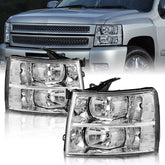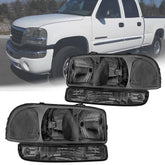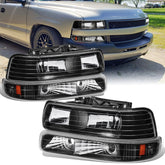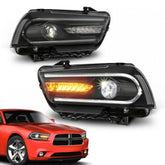How to turn on the headlights on your vehicle?
When you drive at night, turning on and using the headlights correctly will add a layer of security to your nighttime driving, which protects you and other vehicles or pedestrians on the road.
Operating the headlights is very simple. In this article, we will show you how to find your headlight switch and teach you how to turn on the headlights on your car.
Common headlight switch locations
Before turning on the headlights, one thing you must do is find the headlight control. If you can't find control, you've lost the key to open the door. Of course, different types of vehicles may have different controls, and the location of the controller may also be different. Here are the common locations of the headlight switch:
The left side of the dashboard
In earlier vehicles from the 1960s, 1970s, and 1980s, the headlight switch was a rotary push button type, located on the driver's side of the dashboard for easy access by the driver. It usually consisted of a rotary dial that the driver could turn left or right to control the headlights. There would be scales on the dial, and some indicator symbols for the lights formed these scales.

Control lever on the steering wheel
This is the most common design in today's era. The switch is integrated into the control lever on the left or right side of the steering wheel. The control lever is usually rectangular or round. The user can turn the headlights on or off by turning or sliding the control lever. We generally call this type of switch a rocker switch. The light indicator is marked on the dial.

Center console
A few models may design the headlight switch on the center console, usually with other vehicle controls.
Touch screen interface
Some modern models, especially electric and high-end models, may control the headlights on and off and the mode through the interface of the center console touchscreen.
Recognize the symbols
Parking Light

Low Beam Headlamp

High Beam Headlamp

Fog Light

Automatic Setting

Light Controls

How to turn on your headlights?
Now that you've located the headlight switch and reviewed the light symbols, follow the steps below to turn it on (using a rocker switch as an example). Let's get going!
Step 1: Find the "OFF" position
Under normal circumstances, when you don't turn on any lights, there will be a "dot", a "short line" or a small "triangle" on the lever aligned with "OFF", which is the indicator of the light off, usually located at the bottom left of the lever. When this "dot", "short line" or "small triangle" corresponds to the corresponding symbol, it means that the light of the corresponding symbol is working.
Step 2: Find the light symbol you need
We reviewed the light symbols earlier, and now it's time to put them to use. Hold the dial with your left thumb and index finger. When you turn the dial to the light symbol you want, you will feel a noticeable pause in your hand and hear a "click" sound. Let's try to turn on several commonly used lights.
Step 3: Turn on Parking Light
Parking lights are the lights we use most frequently. We turn the dial to the parking light symbol, and then the front and rear of the car will light up, usually orange in the front and red in the rear. For some vehicles, you may have an indicator on your dashboard so you can see it.
Step 4: Turn on the Low Beam Headlamp
The next commonly used light is our low beam. It usually provides forward or side light while minimizing glare. When you are driving on city streets or streets with a lot of people, please try to use the low beam to avoid glare that affects pedestrians and other drivers on the road. Put the safety of yourself and others first.
Step 5: Turn on the High Beam Headlamp
High beams are strong and will produce greater glare, which can easily dazzle other drivers, so we usually use them in areas with few people, no light, or dark environments. The controller for the high beam usually appears at the same time as the turn signal symbol, separate from the low beam controller. You can turn the high beam on or off by pushing or pulling the turn signal controller forward or backward.
Step 6: Turn on the Fog Light
The location of fog lights varies. Sometimes they are on the same dial as low beam lights, but some manufacturers set the fog light button separately and give it a dedicated position to facilitate the driver to distinguish and operate it. It is recommended to use fog lights in some extreme weather conditions (such as fog, rain, snow, etc.). In extreme weather, the visibility of fog lights is higher than that of low beam lights, which helps us improve road safety.
Automatic headlight control
With the development of technology, in addition to manual control of lights, more and more vehicles are now equipped with automatic headlight control. Today we also take this opportunity to introduce it to you. This is an advanced vehicle function that can automatically adjust the vehicle's headlight system to adapt to different driving environments and lighting conditions. Here are some things you need to know:
How to activate the automatic headlight function?
Find the control switch for the automatic headlights on the vehicle's dashboard or multi-function steering wheel. Usually, this switch will be marked "Auto" or have an icon with automatic headlights (it may be a light bulb icon with the letter "A" or the word automatic). Set the switch to the "Auto" position. With this setting, the headlight system will automatically turn on or off depending on the intensity of the external light.
How automatic headlights work
When the system is activated, it uses the light sensor on the front of the vehicle to monitor the intensity of the external ambient light. When the environment becomes dark (such as entering a tunnel, dark, etc.), the automatic headlights will automatically turn on. When the ambient light is sufficient or the day is bright, the headlights will automatically turn off.
Automatic high and low beam switching function
If your vehicle supports automatic high and low beam switching, the system will monitor the lights of vehicles on the road ahead through the front camera. The system will automatically switch from high beam to low beam when it detects oncoming vehicles that may cause glare. When the oncoming vehicle passes, the system will automatically restore the high beam to provide a better view.
System limitations
Although the automatic headlight system is very intelligent, in some extreme weather conditions (such as fog), the system may not be able to accurately judge the external light. In this case, it is recommended to manually control the headlights. Understand the specific settings and limitations of your vehicle's automatic headlight system. Reading the owner's manual can provide more detailed information.
When to use headlights?
Knowing how to operate headlights is not enough to cope with various situations in life. You also need to know when to use headlights. Here are some common situations we list:
- At night. If there are not many people around, you can boldly use high beams. But if there are many cars and people around, you can only use low beams.
- When visibility is low, such as in the early morning or evening, you can already use low beams.
- If you encounter bad weather, such as rain, snow, fog, or even sandstorms, it is very necessary to turn on your fog lights. At this time, do not turn on high beams, which will only make it more difficult for you to see the road because of glare in these weather conditions.
- When entering a tunnel or passing through a dark area with dense tree cover, you should turn on your headlights to enhance your vision.
- In a busy urban environment, turning on the headlights can also help other drivers and pedestrians notice your vehicle more easily despite the presence of street lights.
Conclusion
That's how you operate your vehicle's headlights. I hope you found this article helpful and that you are now familiar with operating your headlights. Also, remember that this is just a guide. If you want more precise help, you will need to read the owner's manual for your specific vehicle to learn how to turn your headlights on and off, high beams, automatic headlights, and parking lights. If you need to replace your headlights, you can find the right headlight kit or headlight bulbs for you in the MOSTPLUS online store.
FAQs
What should I do if my headlights don't work?
If your headlights don't work, first check that the headlight switch is set correctly and make sure the bulbs are not burned out. Next, check that the relevant fuses are not blown and that the relays are working properly. Also, confirm that all connections are secure and free of corrosion. If your vehicle is equipped with automatic headlights, you should also check that the light sensor is not blocked or dirty. If the problem is not solved after these basic checks, it is recommended to consult a professional auto repair technician for further diagnosis and repair.
How do warning lights work?
Warning lights, commonly known as hazard lights or emergency lights, are activated by a button to make all of the vehicle's turn signals (front, back, left, and right) flash simultaneously. This feature is mainly used in emergencies, such as when the vehicle is stopped on the road due to a breakdown, to alert other road users that the vehicle is in an abnormal state, thereby improving safety. This warning light is designed to attract the attention of other drivers and prevent accidents.
What do the warning symbols on the dashboard mean?
When your headlights are malfunctioning, your vehicle may display the standard headlight indicator symbol with an exclamation point (!) or "x". Or, it may display the low beam indicator with an exclamation mark. At this point, you should replace or repair the corresponding headlight.
Featured Products
- $116.99
$124.45- $116.99
- Unit price
- / per
- $96.99
$99.99- $96.99
- Unit price
- / per
- $96.99
- $96.99
- Unit price
- / per
- $368.99
$435.77- $368.99
- Unit price
- / per














